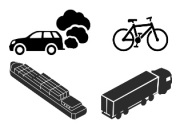Functional unit and reference flow
Definition of the Functional Unit (FU)
Fundamental :
The functional unit makes it possible to quantify the function performed by the products or services studied by the LCA (referred to as the service rendered).
It depends on the objectives of the LCA, as defined above, and is used as a reference.
Legal text : Definition ISO
The UF corresponds to the ‘quantified performance of a product system intended to be used as a reference unit in a life cycle assessment’.
ISO 14040-44:2006 standard
Examples of Functional Unit (FU)
Example : Transport
If you want to compare different modes of transport, for example a car and a bus, we can use the functional unit: « moving one person over 10km ». We can also add elements relating to comfort conditions, maximum travel time, etc.

Example : Hand drying

If you want to compare several hand drying methods, the functional unit can simply be ‘dry a pair of hands’.
Definition of Reference Flow (RF)
Fundamental :
The reference flow corresponds to the means used to ensure the functional unit selected for the LCA. This may be a fraction of a product, a quantity of electricity, a quantity of water, etc.
Legal text : Definition of ISO
The RF corresponds to the ‘measure of process outputs, in a given product system, required to fulfil the function as expressed by the functional unit’.
Standard ISO 14040-44:2006
Examples of Reference Flow (RF)
Example : Transport
With the functional unit ‘Move a person 10km’, if we study the case of the car, the reference flow can be made up of the following two elements:
A fraction of a car, for example 10/200,000th if we consider a lifetime of 200,000 km.
The volume of petrol needed to cover 10km.

Example : Handy drying
With the ‘Dry a pair of hands’ functional unit, the reference flow will depend on the medium used.
For the paper towel, the following reference flow is used: ‘x cm²’. Where x is the surface area required to dry a pair of hands with this paper towel.
For the electric hand dryer, the flow can be: ‘y a fraction of the hand dryer and z electricity consumption’. With y calculated from the lifetime of the appliance and the time required to reach the functional unit, and z the power consumption to reach the same functional unit.
Note : Product fraction
The fraction of the product is understood to be the fraction of the product's life cycle. In other words, the entire product life cycle is assessed (raw materials, manufacture, transport, use and end of life), but only a fraction of the results is allocated to the functional unit.